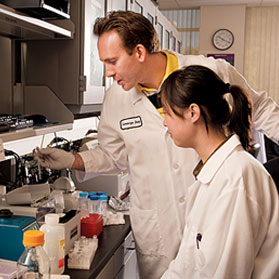Building on basics: Nanoparticles with a punch
 Patients undergoing chemotherapy are sometimes counseled to think of the toxic drugs as an army that’s helping them fight for their lives. Unfortunately this army uses its force indiscriminately, attacking the entire body in an attempt to wipe out the cancer cells lurking within it.
Patients undergoing chemotherapy are sometimes counseled to think of the toxic drugs as an army that’s helping them fight for their lives. Unfortunately this army uses its force indiscriminately, attacking the entire body in an attempt to wipe out the cancer cells lurking within it.
"Chemotherapy doesn’t just go where you want it, it goes everywhere," says Lorenzo Berti, an assistant research chemist in the Department of Internal Medicine. Berti is researching a more refined approach to attacking cancer, for which he’s been awarded a $450,000 grant from Susan G. Komen for the Cure.
"We’ve made huge progress in 30 years, and I’m always very gratified when I meet women who are surviving breast cancer for many years," said Ambassador Nancy G. Brinker, founder and CEO of Susan G. Komen for the Cure. "Research like this at UC Davis may help people with breast cancer take charge of their health by giving them a more aggressive and ambitious method of fighting their tumors."
Berti is exploring how nanoparticles might be used to deliver localized chemotherapy to tumors. He wants to arm infinitesimally small magnetic crystals of iron oxide – a nontoxic and inexpensive material – with drugs and deploy them in the body to invade and destroy cancerous tissue. The nanoparticles would travel benignly through the bloodstream until reaching enemy territory – a tumor – where they’d let loose their cancer-fighting arsenal.
"The advantage of this approach is that it’s a platform. You can switch out the components."
Berti’s battle plan takes advantage of a peculiarity of the blood vessels that grow within malignant tumors to supply the rapidly growing and dividing cancer cells with nutrients and oxygen. The walls of these blood vessels, unlike those in healthy tissue, are pockmarked by holes. Berti plans to use these holes as a point of entry for cancer-fighting nanoparticles to invade tumors. The nanoparticles that Berti is using in his research are 50 to 200 nm (nanometers) in diameter – about the size of viruses.
"They’re big enough that they can’t squeeze through the walls of normal blood vessels, but when they get to the cancerous blood vessels and find these big holes, they fall through them. Tumors tend to retain nanoparticles in this size range. These particles are the scaffolds onto which we’ll load drugs."
Berti plans to attach two cancer-fighting agents to the iron oxide nanoparticles. One, doxorubicin, is a commonly used chemotherapy agent. The other, Berti says, "is essentially a DNA sequence designed to weaken cancer cells," making them more susceptible to attack by the chemotherapy drug.
"It’s a one-two punch," he says.
Making the drugs adhere to the nanoparticles is difficult, Berti adds, but he intends to do that by first coating the particles in a polymer that imparts a positive charge. The DNA drug, which has a negative charge, will then stick to the nanoparticles. The chemotherapy drug – doxorubicin – has a strong affinity for the DNA drug, so it will in turn latch on.
 Once these drug-toting nanoparticles have accumulated within a tumor, application of a magnetic field could trigger them to break down and release their anti-cancer arsenal.
Once these drug-toting nanoparticles have accumulated within a tumor, application of a magnetic field could trigger them to break down and release their anti-cancer arsenal.
"It’s like a little Russian doll, with everything nested in there," Berti says.
Once these drug-toting nanoparticles have accumulated within a tumor, application of a magnetic field could trigger them to break down and release their therapeutic attack.
There’s even more to Berti’s battle strategy, though. The temperature of iron oxide nanoparticles increases when they’re exposed to a magnetic field – one that’s otherwise harmless to the body. Prompting the nanoparticles to heat up once they’ve invaded a tumor could provoke further weakening of the cancer cells, thereby making malignancies even more susceptible to the chemotherapy drug.
Because the iron oxide nanoparticles are magnetic, their distribution could be monitored using magnetic resonance imaging (MRI), allowing clinicians to see the particles accumulated in a tumor, and to monitor a patient’s progress by comparing the patterns of accumulation over the course of cancer treatment.
Berti plans to test his localized chemotherapy technique on animal models of breast cancer initially. He says that if it’s successful, similar nanoparticles could be used to fight many different kinds of cancer.
"The advantage of this approach is that it’s a platform," Berti says. "You can switch out the components. You can try different combinations of drugs."
Berti says that iron oxide nanoparticles, which are used as an ingredient in some MRI contrast agents, pose no danger to patients.
"In terms of safety, the real thing you have to worry about is the drug, not the particle," Berti says. If his method works, far fewer of those toxic chemotherapy agents will be needed to triumph over cancer.






